
The geometer moths are moths belonging to the family Geometridae of the insect order Lepidoptera, the moths and butterflies. Their scientific name derives from the Ancient Greek geo γεω, and metron μέτρον "measure" in reference to the way their larvae, or inchworms, appear to measure the earth as they move along in a looping fashion. A very large family, it has around 23,000 species of moths described, and over 1400 species from six subfamilies indigenous to North America alone. A well-known member is the peppered moth, Biston betularia, which has been subject of numerous studies in population genetics. Several other geometer moths are notorious pests.

The small fan-footed wave is a moth of the family Geometridae. The species was first described by Johann Siegfried Hufnagel in 1767.

The small dusty wave is a moth of the family Geometridae first described by Franz von Paula Schrank in 1802. It is found throughout Western, Central and Northern Europe. In the north, its range extends as far as Denmark and southern Scandinavia. In the east its range extends as far as Russia. Idaea seriata is replaced by the subspecies Idaea seriata canteneraria, from the north-east of Spain and the central and eastern Mediterranean to the Crimean peninsula, while the western Mediterranean and the Balearic Islands are inhabited by the sister species Idaea minuscularia. Outside Europe it is found in eastern Algeria, Tunisia, Turkey, Cyprus, the Caucasus and the northwest of Transcaucasia. In Morocco and western Algeria, it is replaced by the sister species Idaea minuscularia. In the British Isles it is common in England and Wales but is only found in the eastern half of Scotland and it is rare in Ireland.

Idaea emarginata, the small scallop, is a moth of the family Geometridae. It was first described by Carl Linnaeus in his 1758 10th edition of Systema Naturae and it is found in Europe.

Idaea filicata is a moth of the family Geometridae. It is found in Southern Europe and the Near East.

Idaea inquinata, the rusty wave, is a moth of the family Geometridae. It is found in Europe.

Idaea ochrata, the bright wave, is a moth of the family Geometridae. It is found in Europe.
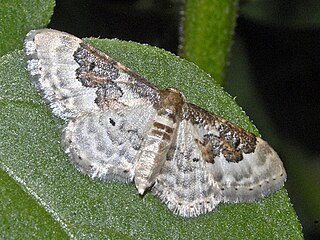
Idaea rusticata, the least carpet, is a moth of the family Geometridae. The species was first described by Michael Denis and Ignaz Schiffermüller in 1775.

Idaea fuscovenosa, the dwarf cream wave, is a moth of the family Geometridae. It is found in the Palearctic,

Idaea straminata, the plain wave, is a moth of the family Geometridae. It is found in Europe including West Russia and Balkans.
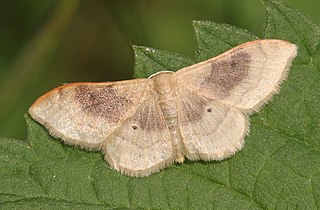
Idaea degeneraria, the Portland ribbon wave, is a moth of the family Geometridae. The species was first described by Jacob Hübner in 1799.

Idaea contiguaria, the Weaver's wave, is a moth of the family Geometridae. It was first described by Jacob Hübner in 1799 and is found in Europe.

Idaea humiliata, the Isle of Wight wave, is a moth of the family Geometridae. It is found in Europe. This species was found on the Isle of Wight but became extinct around 1931. There was one sighting in Portsmouth in 1954 but the moth appears to be currently extinct in the United Kingdom.
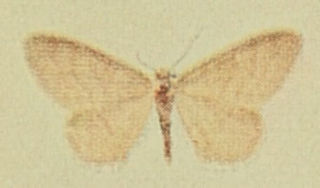
Idaea dilutaria, also called the silky wave, is a moth of the family Geometridae. It is found in Europe.

Idaea laevigata, the strange wave, is a moth of the family Geometridae. It is found in Central Europe and Southern Europe. It occurs in Britain as an imported species.

Idaea deversaria is a moth of the family Geometridae. It is found in most of Europe, east to central Asia and southern Siberia.
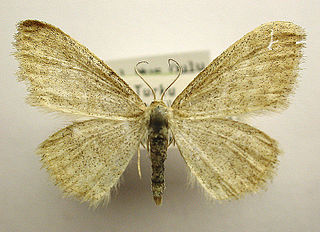
Idaea pallidata is a moth of the family Geometridae. It is found from northern and central Europe to the Caucasus, central Asia and the Amur Region.

Idaea subsaturata is a moth of the family Geometridae. It is found in the coastal regions of the Iberian Peninsula, northern Spain and in small populations near Madrid and in northern Portugal. It is also found in isolated populations in France. It is also found in North Africa, from North-eastern Morocco and northern Algeria up to Tunisia and western Libya.

Phiaris bipunctana is a moth of the family Tortricidae. It is found in most of Europe, east to the eastern part of the Palearctic realm. It was recently discovered in Canada (Manitoba).
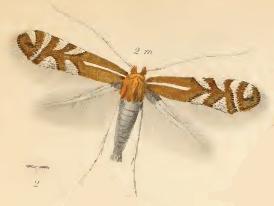
Phyllonorycter junoniella is a moth of the family Gracillariidae. It is known from all of Europe, except Ireland, the Iberian Peninsula and the Balkan Peninsula.



















